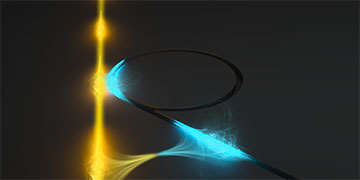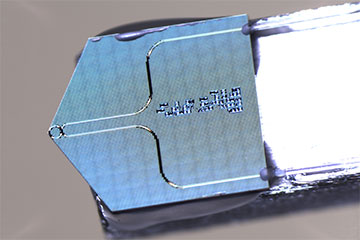
An artist’s impression of a beam of electrons (yellow) generating photons (blue) within an adjacent microresonator. Researchers in Germany and Switzerland have shown they could tie each photon produced in this way to the corresponding electron, suggesting the technology’s suitability for heralding schemes and correlation-enhanced imaging. [Image: R. Allen / Second Bay Studios]
Many experts reckon that quantum information systems have the potential to transform a range of technologies, from computing and communications to sensing and imaging. But fully exploiting this potential usually involves controlling single quantum particles with exquisite precision—which isn’t easy.
Now physicists in Germany and Switzerland have developed a microresonator-based scheme for generating correlated pairs of quantum particles, one a photon and the other an electron (Science, doi: 10.1126/science.abo5037). They say that one of the particles could be used to monitor the state of the other, easing some of the difficulties associated with manipulating delicate quantum states, while correlations between the two can be exploited to reduce noise in certain types of imaging.
Electrons and photons
The demonstration was carried out by Claus Ropers and colleagues at the Max Planck Institute for Multidisciplinary Sciences in Göttingen, Germany, and involved a photonic chip made by Tobias Kippenberg and co-workers at the Swiss Federal Institute of Technology in Lausanne, Switzerland. The idea was to direct a beam of electrons from an electron microscope at a microring resonator on the chip, causing some of the electrons to scatter inelastically. These electrons lose energy such that they generate exactly one photon within the resonator.

An optical chip with a microring resonator and a fiber optic coupling. [Image: A. Feist / Max Planck Institute for Multidisciplinary Sciences]
Using electrons with an energy of 120 keV, the researchers were able to distinguish between scattered and non-scattered electrons by deflecting the particles in a magnetic field and then registering their arrival time and energy in an event-based electron detector. The scattered electrons were slightly slower and therefore deflected more by the magnetic field than their unscattered counterparts. At the same time, photons created in the 114-µm-wide silicon-nitride resonator were tapped by a waveguide and sent through an optical fiber to a single-photon counter—at which point the photon corresponding to any particular electron could be identified using a coincidence detector.
Ropers, Kippenberg and colleagues built up a histogram showing the relationship between the energy lost by each electron and the time delay between it and the nearest arriving photon. This chart displayed two main features: a background of electrons with zero energy loss and random arrival times—which were the accidental coincidences—and a major concentration of events with no delay and an energy loss of 0.8 eV—which was exactly the energy sapped from those electrons to generate photons in the resonator.
Inter-particle heralding schemes
The researchers then inserted a slit into the spectrometer used to measure the electron’s energy to register only the scattering electrons, allowing greater electron fluxes before the detector saturated. This allowed them to isolate just those events which corresponded to the generation of electron-photon pairs, within a coincidence window a mere 4 ns wide. They say that, in contrast to conventional optical spontaneous parametric down-conversion, the measurement of each electron’s energy reveals precisely the number of photons created in the microresonator.
This setup makes possible what are known as inter-particle heralding schemes—in this case, the detection of a photon to herald the arrival of its corresponding electron or vice versa. The Swiss-German team found that the electrons were far more efficient heralders than the photons, signaling about 57% of all coincidences compared to the latter’s paltry 0.1%. But they say that technical improvements to single-photon collection, such as the use of superconducting detectors and more efficient out-coupling of photons, could push the latter figure up to around 50%, if not higher.
Although the efficiency of coincidence detection leaves plenty of room for improvement, fidelity is already high. The researchers found that only about 1 in 75 of what were flagged to be coincidences between a specific electron and photon were instead uncorrelated events. This, they say, shows the scheme’s promise for quantum-enhanced imaging, in which electron-photon correlations allow physical scattering events to be isolated from background noise, such as detectors’ dark counts, and thereby boost the signal-to-noise ratio.
While challenges remain in transforming their research into a workable, compact device, Ropers, Kippenberg and colleagues are confident that the technology could find use in a range of applications, from enhanced imaging and sensing to photonic quantum-state synthesis. “By merging free-electron quantum optics with integrated photonics,” the researchers wrote in their paper, “we provide a pathway toward a new class of hybrid quantum technology that relies on entangled electrons and photons.”
